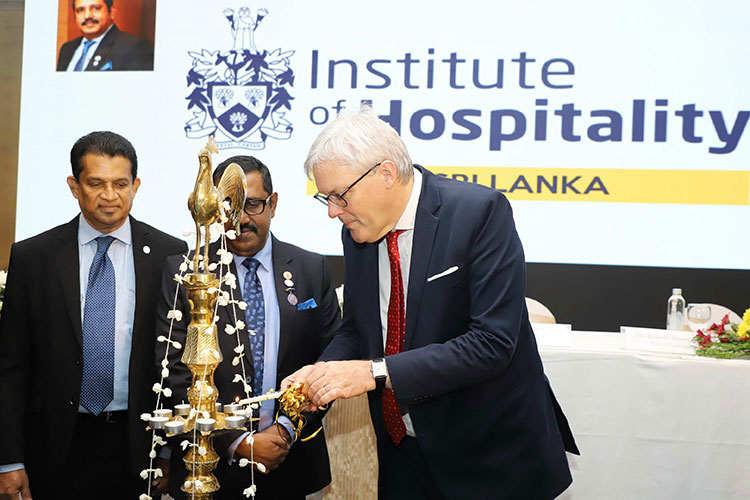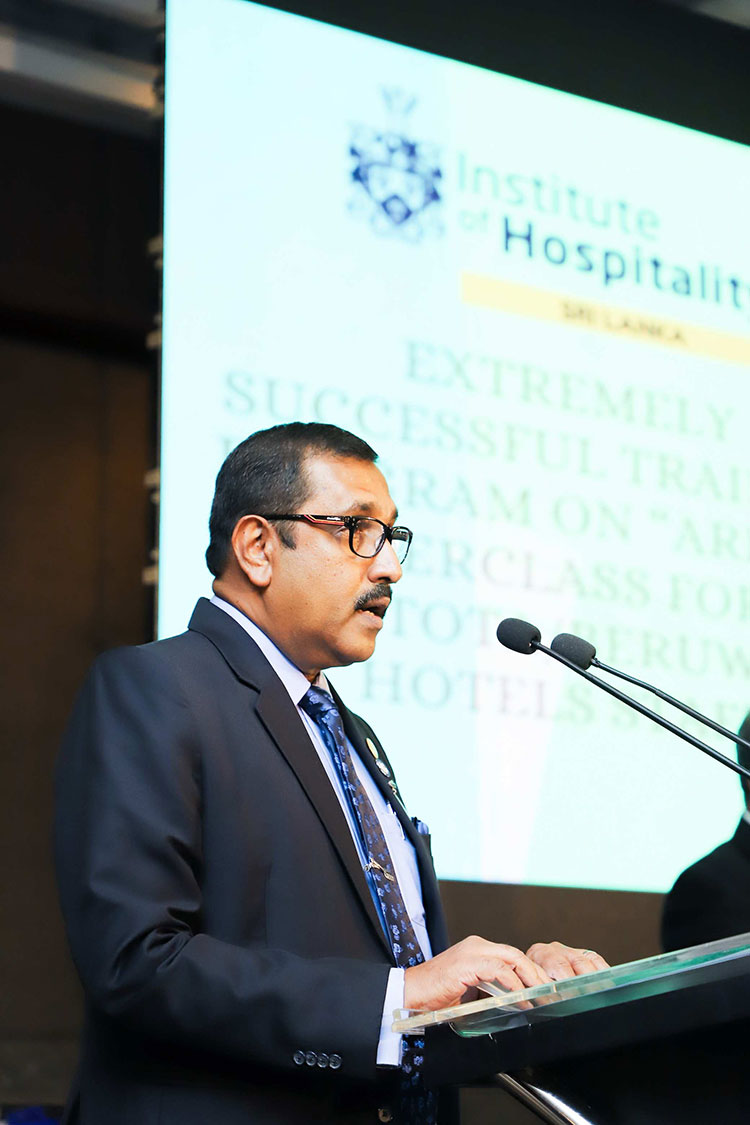Life style
How Sri Lanka’s batik artists keep the craft alive
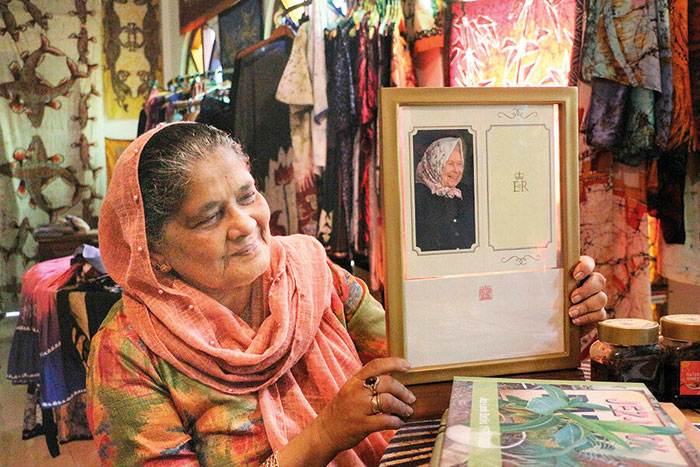
By Zinara Rathnayake
Jezima Mohammed has run a small workshop and boutique, Jez Look Batiks, from her home in Matara, Sri Lanka, for nearly seven decades. Now in her 80s, she still works every day. When visitors stop by, the batik artist proudly shows off framed letters from Buckingham Palace and a photo of Queen Elizabeth II sporting a white satin scarf with baby pink florals – one of her designs. Meanwhile, outside, a group of artisans meticulously outline peacock motifs onto off-white fabric with boiling hot wax.
“They are my girls,” she says of the 16 women currently employed by her shop, “and we work like a family.”
It’s often said that batik came to Sri Lanka from Indonesia, where the art form is recognized by UNESCO as an important part of humanity’s intangible heritage, but late researcher Gerret Pieter Rouffaer believed it was India or Sri Lanka that introduced the resist dyeing technique to the Indonesian islands.
Murky origins aside, batik flourished in Sri Lanka during the 1960s, with female artists like Ena de Silva creating massive tapestries that adorned the ceilings of Colombo’s most iconic buildings. Small businesses such as Ms. Mohammed’s shop emerged to meet the demand for the popular medium. Then, in 1983, civil war brought the industry to an abrupt halt.
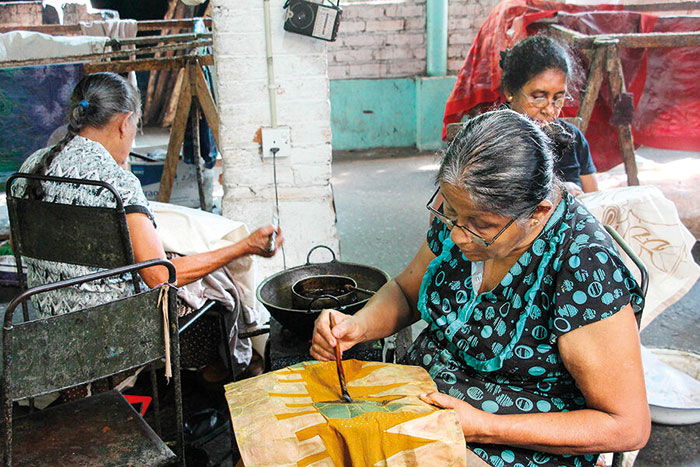
One of 16 female artisans working at Ms. Mohammed’s home batik workshop in Matara, Sri Lanka, focuses on preparing a new design “We work like a family,” says Ms. Mohammed.
It never fully recovered, say artists and historians. Today, lingering impacts of pandemic lockdowns and record-high inflation make it difficult for cottage artisans to afford supplies, while waning interest in batik apprenticeship threatens the beleaguered art form’s future. Still, batik continues to endure thanks to passionate artists across the island. In fact, industry veterans such Ms. Mohammed say that decades of war and other hardships have helped prepare them for modern challenges.
“One thing is certain,” she says. “You have to keep going. You can’t stop your work. If you do, batik will stop.”
Careers defined by perseverance
Before the Sri Lankan Civil War, Ms. Mohammed’s workshop brimmed with curious outsiders wanting to learn about batik. “One traveler who came here mentioned me in an old guidebook, so everyday there was someone. Tourists loved it,” Ms. Mohammed says.
Making a batik garment starts with drawing the design on paper and planning out each colour. Using a copper stylus and a mix of hot paraffin and beeswax, an artisan then outlines the pattern onto both sides of a natural, white fabric, which is then immersed in dye, starting with the lightest color.
After the pigment sinks in, the artist can remove the wax with boiling water and move onto the next element of the design, repeating this process of waxing, dyeing, and boiling until the pattern is complete. The finished cloth is washed with soap and sun-dried before it’s sewn into kimonos or other garments. Ms. Mohammed also designed bedding, curtains, and staff uniforms for popular seaside hotels.

Colourful batik designs fill the entrance of artist Gnana Prabha Ranasinghe’s home, which has been converted into a small boutique in Galle, Sri Lanka. Ranasinghe is one of the island’s few male batik designers
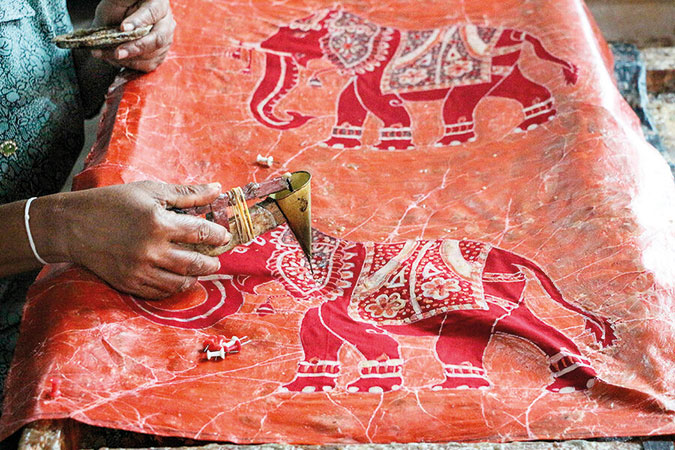
A batik artist outlines a design using hot wax, a key step in the resist dyeing technique. The finished cloth is washed with soap and sun-dried before its sewn into kimonos or other garments.
“It was a very bright, happy time,” she says. “Then the war started.”
As long standing ethnoreligious tensions erupted into violence across the island, those curious outsiders dwindled, but thanks to her now-international reputation for popular, fashionable garments, Ms. Mohammed was able to maintain a niche market for her designs. Former visitors and hotel owners continued to order new prints, and she was also invited to overseas workshops and exhibitions.
Still, times were tough, and she often found herself relying on the generosity of others.
“I met many kindhearted people who helped me a lot. When business was slow, my sons gave me small loans to pay my girls,” Ms. Mohammed says.
During lockdowns, she bore that lesson of community in mind, allowing her fellow artisans to work whenever they could and making sure they always had dry rations. “We are a team, and we have to look after each other,” Ms. Mohammed says.
Nowadays, Sri Lanka’s cost-of-living crisis makes it difficult to afford kerosene oil, Ms. Mohammed says. She goes out daily to buy dried coconut shells as an alternative fuel for her artisans’ wax burners.
It’s a devotion shared by other batik veterans, such as Gnana Prabha Ranasinghe, who resides in the southern city Galle and is one of Sri Lanka’s few male batik designers. Like many Sri Lankan crafts, batik is widely seen as a job for women, but Mr. Ranasinghe was eager to inherit his family’s home-based workshop in the 1970s.
Christian Science Monitor
Life style
Camaraderie,reflection and achievements

Institute of Hospitality Sri Lanka
 The 32nd Annual General Meeting (AGM) of the UK-based Institute of Hospitality’s Sri Lanka Chapter was held recently at the Ramada Hotel Colombo,.The event provided an evening of camaraderie , reflection of the past and present achievements,setting new benchmarks for the future
The 32nd Annual General Meeting (AGM) of the UK-based Institute of Hospitality’s Sri Lanka Chapter was held recently at the Ramada Hotel Colombo,.The event provided an evening of camaraderie , reflection of the past and present achievements,setting new benchmarks for the future
The AGM had the presence of two distinguished guests, the Chief Guest Opposition Leader Sajith Premadasa, and the Guest of Honour British High Commissioner to Sri Lanka, Andrew Patrick. Their inspiring speeches were lauded by all hoteliers who were present at the occasion
A special thanks was extended to Robert Richardson, CEO of the Institute of Hospitality UK, along with his team, sponsors, committee members, and all attendees for making the event memorable.
Dr. Harsha Jayasingh, Past President of the Institute of Hospitality (UK) Sri Lanka Chapter, emphasised the Institute’s longstanding history and the strength of its Sri Lankan branch. “The Institute of Hospitality (IH) UK has a history of 86 years, and we are proud to be the Sri Lanka Branch. IH Sri Lanka is much stronger now with many members from all areas of the hospitality industry,” he stated.
Dr. Jayasingh highlighted the significant role of tourism in Sri Lanka’s economy,. He said tourism it is the third-largest source of revenue for the country. “Tourism accounts for about 13.3% of total foreign exchange earnings and employs 450,000 people directly and indirectly. The hospitality industry in this island of pearl holds tremendous potential for economic growth, job creations, and cultural exchange,” he added.
He also pointed out more women should be attracted to the industry and advocated for the use of technology in hospitality sector to attract the younger generation.
The newly appointed Chairman Ramesh Dassanayake spoke about the challenges faced by the industry, including the reluctance of youth to join the sector. . Dassanayake expressed concerns over the migration of staff between hotels and the overall ‘brain drain’ in the sector. ” We must maintain high standards in the hotel We must try to attract tourists to Sri Lanka, we must have with many facilities Hence, hotel schools and other professional institutions involved in skills development mustincrease their intakes,” he pointed out.
Chief Guest Sajith Premadasa emphasised the importance of eco tourism and said “We need to have an environmental policy related to tourism in place,” . .
The 32nd AGM of the Institute of Hospitality UK, Sri Lanka Chapter, was a testament to the strength and potential of Sri Lanka’s hospitality industry. The insights and commitments shared during the event set a new benchmark for the future.(ZC)
Pix by Thushara Attapathu
Life style
He recognizes human identity beyond boundaries of gender, race, nationality and religion.
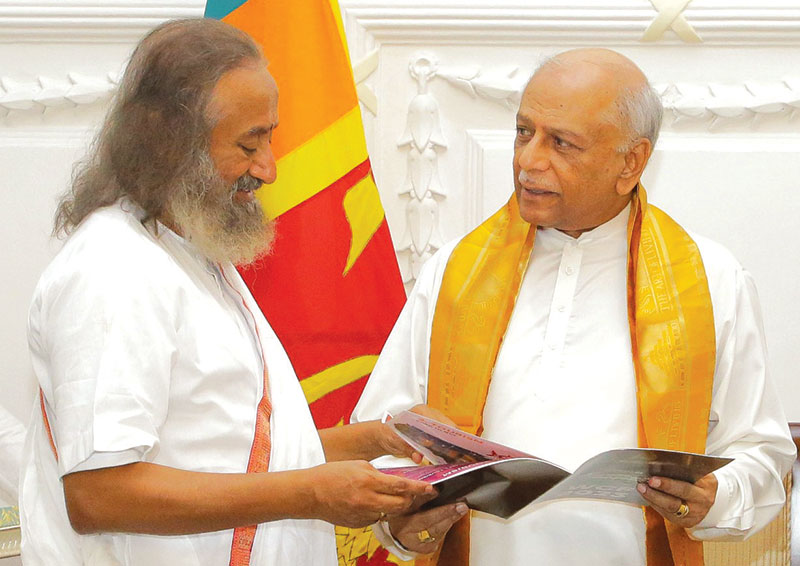
Visit of Sri Gurudev to Sri Lanka
Humanitarian, spiritual leader and Global Ambassador of Peace Gurudev Sri Sri Ravi Shankar (Sri Gurudev) was in Sri Lanka on a three day tour on the invitation of the Prime Minister of Sri Lanka Dinesh Gunewardene. Gurudev who inspired a wave of volunteerism and service to moot one of the largest volunteer-based organisations in the world – The Art of Living – visited the various projects under the aegis of the foundation and launched twelve vocational and technical centers around the island. He was accompanied by thousands of followers from Sri Lanka and around the world.
Gurudev who visited Sri Lanka for the sixth time also had a first day cover launched in honour of his visit. He is a strong proponent of spreading happiness, using the unique Sudarshan Kriya, yoga, meditation and practical wisdom to unite people, empower individuals and transform communities. His programmes provide techniques and tools to live a deeper, more joyous life, while his non-profit organisations recognize the human identity beyond the boundaries of gender, race, nationality and religion.
The Art of Living which has more than 30,000 teachers and over one million volunteers across 180 countries has touched in excess of five hundred million people around the world. CNN called it “Life Changing” and The Washington Post headlined it, “Fresh air to millions”.
In Trincomalee, Gurudev met with war victims and had a heartwarming engagement with the children from the children’s homes run by the Foundation. He also visited the Koneswara Temple in Trincomalee and graced the Kumbhabhishekam at Seetha ecogPnize the human identity beyond the boundaries of gender, race, nationality and religion. Amman temple at Nuwara Eliya. He held discussions with the trustees on the progress of the foundation’s social service projects, while also holding a special event – Ekamuthuwa – attended by a large number of dignitaries and his devotees from around the world.
His time with the Prime Minister was spent discussing the prospects of unity in diversity and uniting Sri Lanka by adding happiness into the formula of living. In addition he had discussions with the Speaker of the Parliament of Sri Lanka Mahinda Yapa Abeywardena, prominent business stewards and civil society leaders.
Life style
Bridal shows with opulence and luxury at The Epitome hotel in Kurunegala
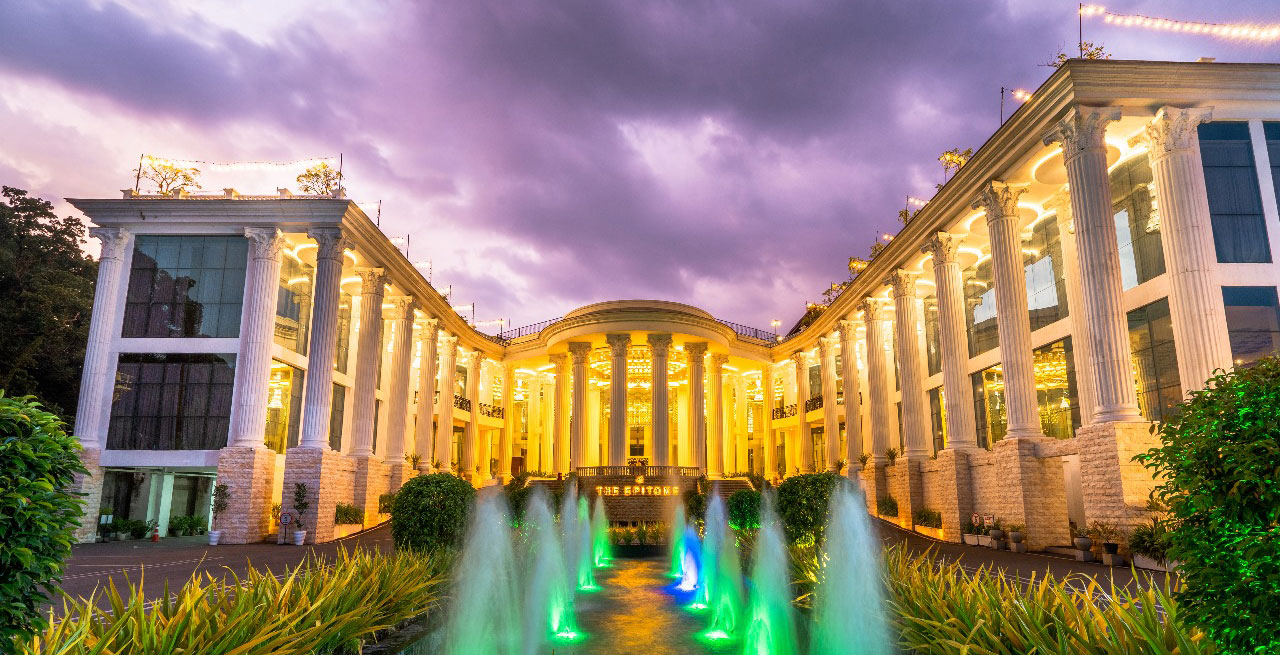
by Zanita Careem
Envison your dream wedding day come to life at the Epitome Hotel, a prestigious city hotel in Kurunegala offering an unrivalled luxury rendors experience for weddings.
The venue is designed to embody opulence and luxury from all quarters for a spectacular wedding in kurunegala,Thier ballroom is the largest banquet facility in Sri Lanka It can be divided into six luxurious pillarless wedding halls on the ground floor and 25pax smaller banquet halls.
It can be easily named as a five star heaven in the heart of the city contributing to a myriad of immense experiences tailored to inspire and delight wedding experiences.
From opulent décor set up to exquisite table decor, lavish food, every detail is meticulously curated to spark your imagination and ignite creativity for a perfect wedding. The previous prestigious wedding shows season one and season two attracted large crowds
were unique events which gave the wedding vendors and potential clients had an opportunity to connect and interact with each other. Beyond being a showcase it was a chance for the wedding vendors to unite and contribute to the vibrancy of the wedding industry. The wedding show covered all area of the bridal industry providing a comprehensive variety of bridal supplies from Sri lanka and became the most popular bridal exhibitions in Kurunegala.This bridal exhibitions allowed brides and grooms to experience first hand the products and services available from suppliers in Sri Lanka
These wedding shows held at The Epitome created a benchmark and gave an opportunity for vendors to create connections to the utmost satisfaction said Harshan Lakshita Executive Director. of the magnificent Hotel
Our wedding shows featured experts and professionals in every field‘ It covered all areas of the bridal industry provided a comprehensive variety of bridal supplies from Sri lanka and became most popular bridal exhibition in this region.We are always open to everyone to join us at our wedding shows in the future. It is an opportunity to discover the incredible talent within our local wedding and bridal vendors to make meaningful relationships and plan thier special day at our breathtaking hotel The Epitome said General Manager Kavinda Caldera
The Epitome Hotel’s bridal show which will be held end of June will buzz with great ideas,advice and inspiration for all those who plan thier dream wedding
…….
The Hotel Epitome’s Wedding Season 3 will marked excellence, celebration and inspiration for those in the wedding industry. The exhibition halls will resonate with ideas on exquisite bridal wear to decor, florists , photography etc and showshowcase the rich tapestry of talent within the local wedding industry. .




